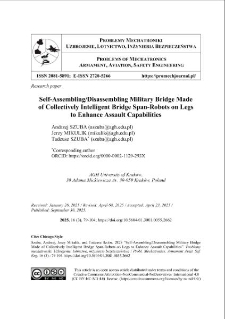Nasza Biblioteka Cyfrowa udostępnia 1 868 obiektów cyfrowych
Obiekt
Tytuł: Self-Assembling/Disassembling Military Bridge Made of Collectively Intelligent Bridge Span-Robots on Legs to Enhance Assault Capabilities ; Self-Assembling/Disassembling Military Bridge Made of Collectively Intelligent Bridge Span-Robots on Legs to Enhance Assault Capabilities
Tytuł odmienny:
Samoczynnie montujący się i demontujący most wojskowy, zbudowany z kolektywnie inteligentnych robotów przęsłowych na nogach, w celu zwiększenia zdolności szturmowych ; Samoczynnie montujący się i demontujący most wojskowy, zbudowany z kolektywnie inteligentnych robotów przęsłowych na nogach, w celu zwiększenia zdolności szturmowych
Współtwórca:
Jerzy MIKULIK, Tadeusz SZUBA ; Jerzy MIKULIK, Tadeusz SZUBA
Abstrakt:
Several specialised implementations of military bridge systems may be distinguished. However, none of them is capable of simultaneously offering all of the following characteristics: versatility, scalability, immediate assembly, ground/terrain survey, low number of staff and low workload. The aim of the article is to present the progress of designing a rather new robotic military bridge system complying with MLC70 and MLC110 standards. It is composed of 11.5 m long mobile AI robots that resemble bridge spans. It is assumed that bridge span-robots are capable of walking short distances to the assembly location, using their strong telescopic legs. In the case of longer distances, the system needs to be transported on specialised semi-trailers. The robots are assumed to be able to disembark/embark such semi-trailers and are also expected to be able to configure themselves and couple with each other to create a bridge ribbon, using railway-like couplers for this purpose. The system is expected to be autonomous, as it is designed to rely on Collective Intelligence. Therefore, only truck drivers and 2-3 qualified technicians would be required to transport and supervise the operation of the robots. The article describes how the key elements of the solution have been combined into a single, compatible and economically feasible system. In order to provide a better understanding of the solution, additional articles are planned in the future. In accordance with military tactics, trucks and trailers transporting bridge span-robots will be attached to fast-moving armoured brigades, as long as local roads may be used. Then, the Intelligent Bridge will self-assemble and will enable to quickly pass through difficult local terrain with such obstacles as rivers, ravines, marshlands, and even engineering barriers consisting of anti-tank ditches and the so-called dragon's teeth. The assumption is that the robotized bridge will enable trucks and semi-trailers to pass a given obstacle. In the next phase, the bridge-robots will pass the obstruction as well, only to self-load onto the semi-trailers and to follow the armoured brigade they are embedded with. The use of telescopic legs as well as the individual and collective intelligence of robots are of crucial significance from the technological point of view. The article presents the outcomes of more than 10 years of research and VR modelling efforts.
;
Several specialised implementations of military bridge systems may be distinguished. However, none of them is capable of simultaneously offering all of the following characteristics: versatility, scalability, immediate assembly, ground/terrain survey, low number of staff and low workload. The aim of the article is to present the progress of designing a rather new robotic military bridge system complying with MLC70 and MLC110 standards. It is composed of 11.5 m long mobile AI robots that resemble bridge spans. It is assumed that bridge span-robots are capable of walking short distances to the assembly location, using their strong telescopic legs. In the case of longer distances, the system needs to be transported on specialised semi-trailers. The robots are assumed to be able to disembark/embark such semi-trailers and are also expected to be able to configure themselves and couple with each other to create a bridge ribbon, using railway-like couplers for this purpose. The system is expected to be autonomous, as it is designed to rely on Collective Intelligence. Therefore, only truck drivers and 2-3 qualified technicians would be required to transport and supervise the operation of the robots. The article describes how the key elements of the solution have been combined into a single, compatible and economically feasible system. In order to provide a better understanding of the solution, additional articles are planned in the future. In accordance with military tactics, trucks and trailers transporting bridge span-robots will be attached to fast-moving armoured brigades, as long as local roads may be used. Then, the Intelligent Bridge will self-assemble and will enable to quickly pass through difficult local terrain with such obstacles as rivers, ravines, marshlands, and even engineering barriers consisting of anti-tank ditches and the so-called dragon's teeth. The assumption is that the robotized bridge will enable trucks and semi-trailers to pass a given obstacle. In the next phase, the bridge-robots will pass the obstruction as well, only to self-load onto the semi-trailers and to follow the armoured brigade they are embedded with. The use of telescopic legs as well as the individual and collective intelligence of robots are of crucial significance from the technological point of view. The article presents the outcomes of more than 10 years of research and VR modelling efforts.
Miejsce wydania:
Warszawa
;
Warszawa
Wydawca:
Wojskowa Akademia Techniczna ; Wojskowa Akademia Techniczna
Data utworzenia:
Data złożenia:
Data akceptacji:
Data wydania:
Rozmiar:
Identyfikator:
oai:ribes-88.man.poznan.pl:2743
Sygnatura:
doi:10.5604/01.3001.0055.2662 ; doi:10.5604/01.3001.0055.2662
ISSN elektroniczny:
ISSN drukowany:
Język:
Licencja:
kliknij tutaj, żeby przejść ; kliknij tutaj, żeby przejść
Właściciel praw:
Wojskowa Akademia Techniczna ; Wojskowa Akademia Techniczna
Strona początkowa:
Strona końcowa:
Tom:
Czasopismo:
Słowa kluczowe:
AI robotics, Collective Intelligence, Intelligent Bridge, bridge span-robot, versatility, scalability, quick assembly/disassembly ; AI robotics, Collective Intelligence, Intelligent Bridge, bridge span-robot, versatility, scalability, quick assembly/disassembly
Kolekcje, do których przypisany jest obiekt:
Data ostatniej modyfikacji:
17 paź 2025
Data dodania obiektu:
17 paź 2025
Liczba wyświetleń treści obiektu:
0
Wszystkie dostępne wersje tego obiektu:
https://ribes-88.man.poznan.pl/publication/3084

